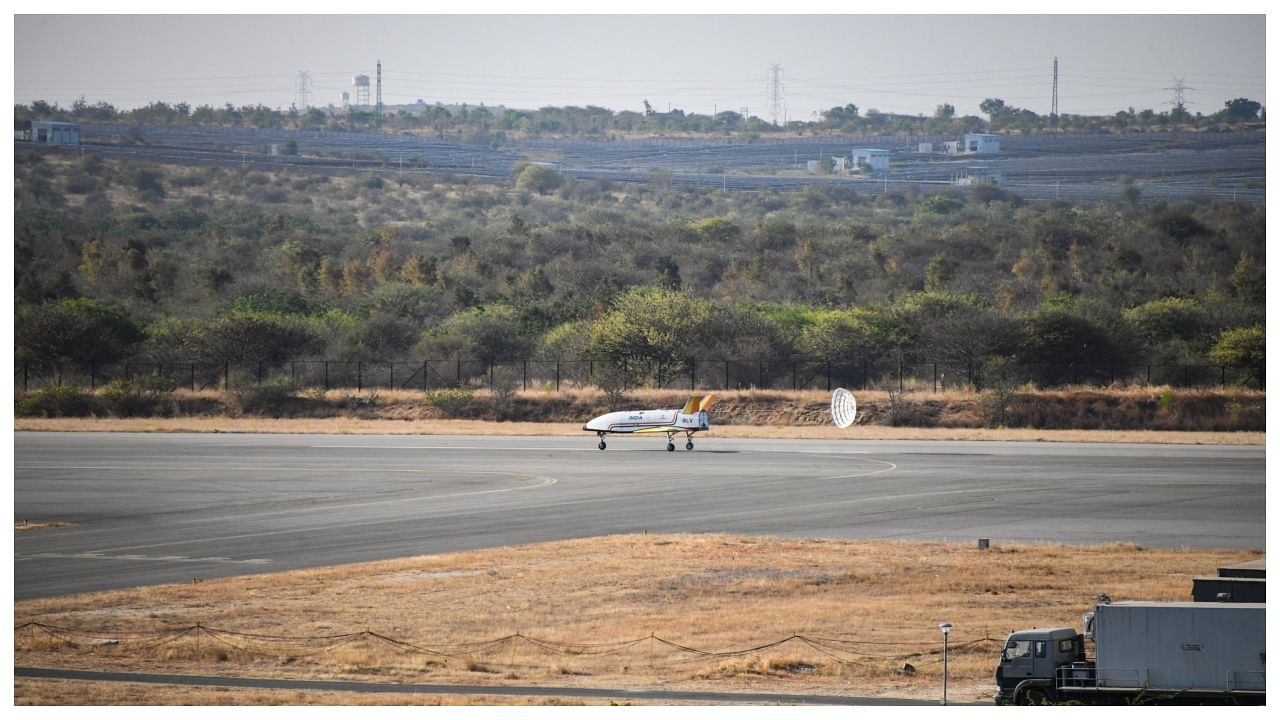
India’s effort to build the ‘space equivalent’ of an aircraft — a reusable space launch system — passed a major milestone on April 2 when the Indian Space Research Organisation (ISRO) successfully carried out the first autonomous landing of its Reusable Launch Vehicle (RLV). An Indian Air Force helicopter carried the winged space plane to an altitude of 4.5 kilometres before releasing it to land like a normal airplane on a runway at the Chitradurga Aeronautical Test Range in Karnataka. The RLV landing experiment (RLV-LEX) reportedly validated all flight parameters such as the high glide angles and speeds the vehicle needed to land safely.
The RLV programme is a game-changer as it can significantly reduce the cost of launching satellites and other spacecraft into orbit. For ISRO, speeding up the RLV’s development could not be happening sooner as all the major space agencies in the world are trying to augment their satellite launch capabilities. While ISRO has the Geosynchronous Satellite Launch Vehicle (GSLV) Mark 3 to launch four-tonne satellites, and the medium lift Polar Satellite Launch Vehicle (PSLV) and the Small Satellite Launch Vehicle (SSLV) for smaller payloads, competitors are constantly raising the bar on their launch potential.
The name of the game is affordability, along with launch frequency: just how quickly a space agency can prepare for its next launch. In that sense, the RLV gives an edge to ISRO by not only cutting nearly 80 percent of launch costs, but also enabling the agency to conduct back-to-back launches with minimal turnaround time.
It is a strange commentary that after more than 50 years since the United States and the Soviet Union pioneered the first space-shots of the 1960s, reaching Low Earth Orbit (LEO) remains so expensive. Even lofting a payload of one kilogramme into LEO costs upwards of $5000. This is because the existing launch systems are of the ‘use-and-throw’ kind — once launched, a rocket booster is useless for further launches, and is discarded. For this reason, space engineers had always toyed with the idea of ‘fly-back’ boosters capable of using aerodynamic lift that can fly back to the launch pad like an airplane. Space planes that have successfully flown include NASA’s Space Shuttle (mothballed in 2011) and the short-lived Russian shuttle Buran — both partially reusable — more recently, Boeing’s robotic X-37B space plane, and China’s secretive RLV Tengyun.
ISRO has been working on its RLV technology for a long time with focus on an aerodynamically-designed vehicle that creates lift as it moves forward. The idea is to use the shape of the craft to generate lift during descent while its delta wing lends stability while landing. This reduces the need for a large heat shield and makes the vehicle lighter and more efficient.
In May 2016, ISRO test flew a scaled-down prototype RLV-TD (Technology Demonstrator) beyond the atmosphere using an expendable rocket. After separation from the rocket, the RLV-TD withstood the intense heat of atmospheric re-entry and glided back to Earth to land on a hypothetical ‘runway’ in the Bay of Bengal from where it was retrieved.
Now that the RLV-LEX has validated its auto landing performance, ISRO would be looking at an early date to carry out the space plane’s next test: the RLV-ORE (Orbital Re-Entry Experiment), where the RLV remains in orbit for a while before re-entering the atmosphere and landing autonomously. Once that is achieved, the RLV test bed could be scaled up to build the first stage of a reusable Two-Stage To Orbit (TSTO) launcher. This involves developing an advanced winged-body for the first stage of the launch vehicle, which will allow it to glide back to Earth after separation. Since the craft itself becomes the second stage, both stages would be recovered and refurbished for future missions. Unlike traditional rocket launches that generate much pollution, the RLV’s environmentally friendly design uses liquid hydrogen, a clean and renewable resource.
However, before the final avatar of the TSTO RLV rolls off the drawing board, ISRO must do a lot of homework to address the engineering challenges involved. The thermal protection system, for instance, must withstand the high temperatures and pressures experienced during re-entry into the Earth's atmosphere and scientists must create materials able to withstand temperatures of up to 1,600 degrees Celsius. Another huge challenge is developing a scramjet engine and air-breathing propulsion systems to take the RLV to the edge of space and bring it back to Earth safely. This will increase its payload capacity and enable travel at hypersonic speeds.
By making space more accessible and affordable, the RLV’s potential applications allow ISRO to dream big and look forward to exciting new chapters in space exploration such as space tourism, space mining, and inter-planetary missions.
(Prakash Chandra is former editor of the Indian Defence Review. He writes on aerospace and strategic affairs)
Disclaimer: The views expressed above are the author's own. They do not necessarily reflect the views of DH.